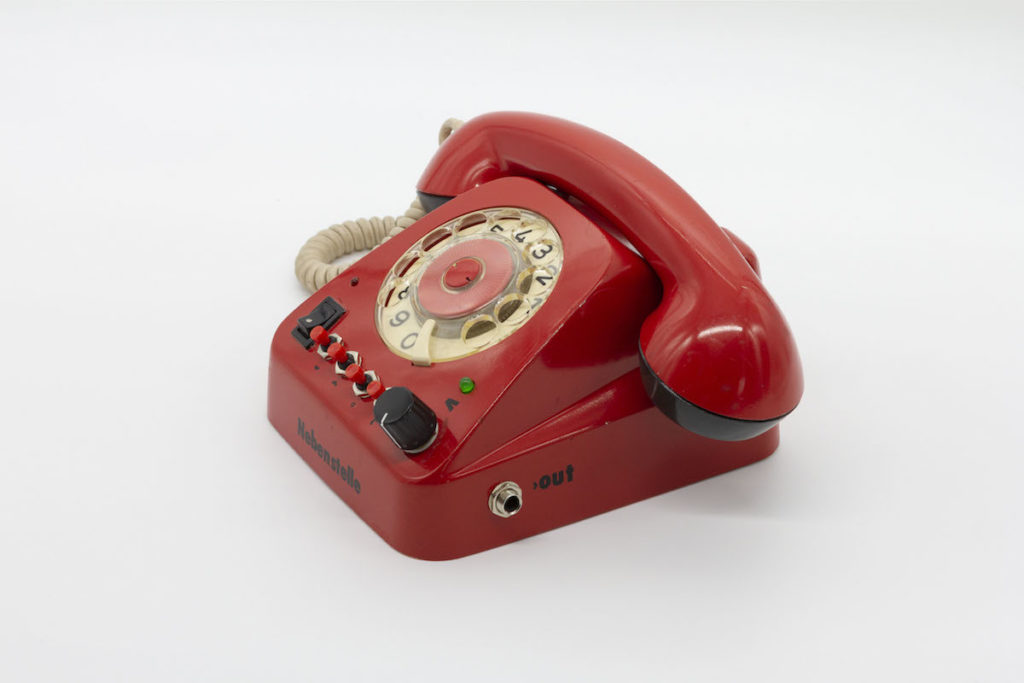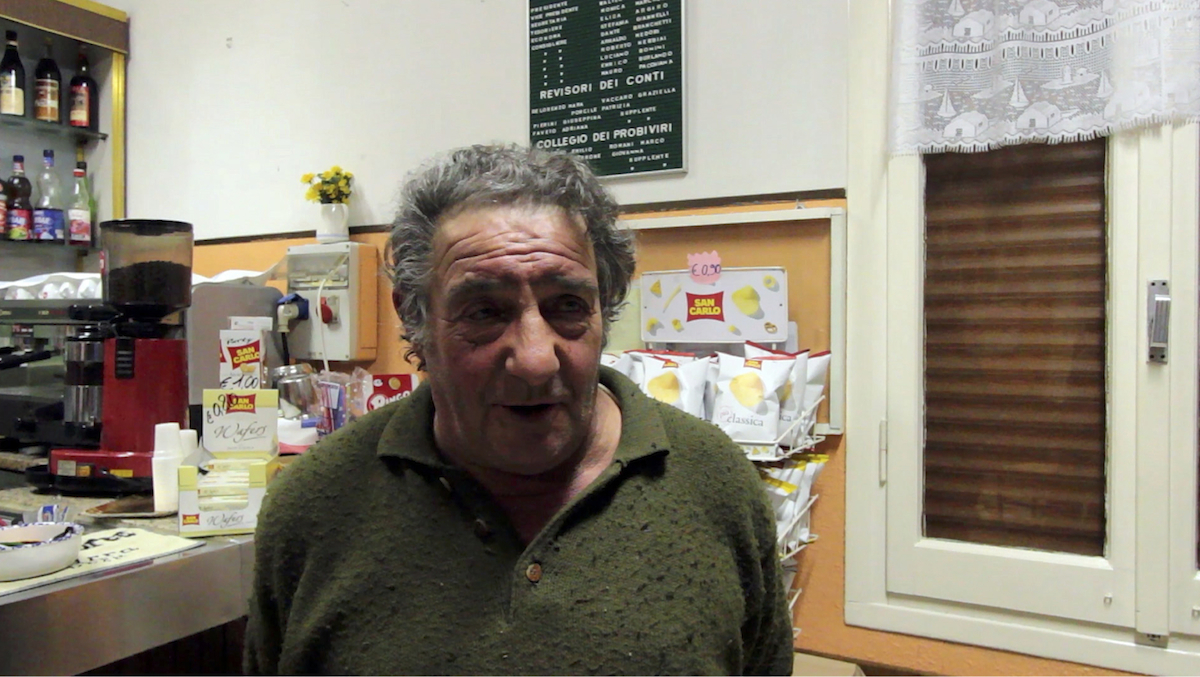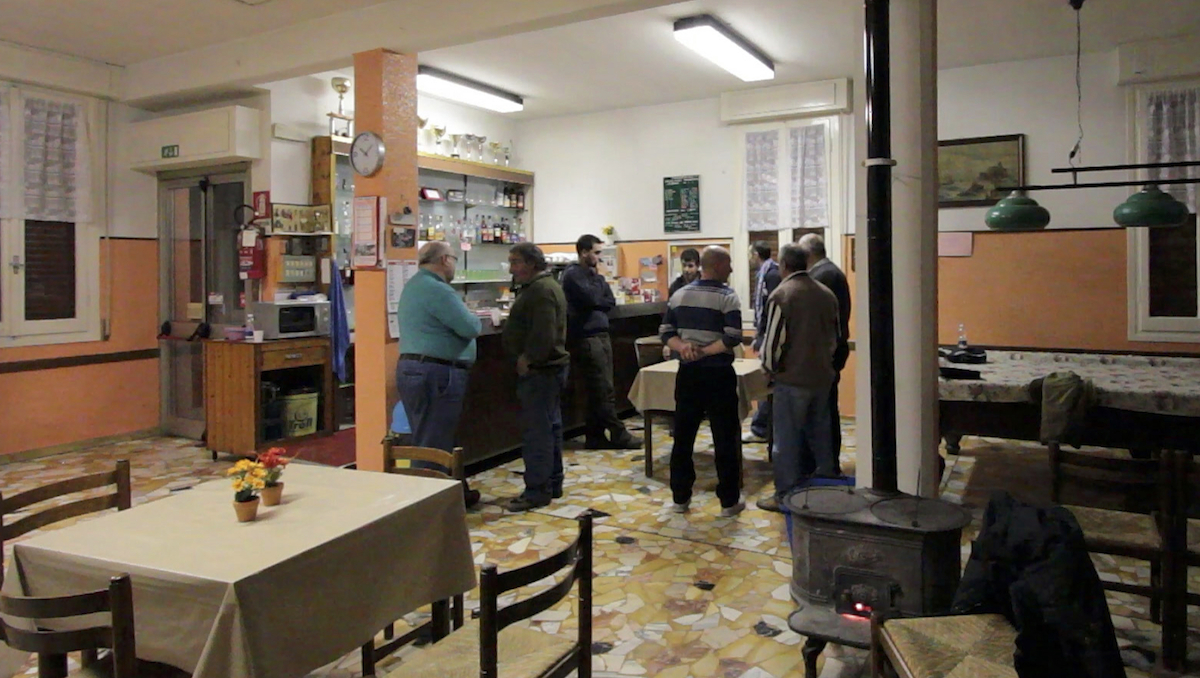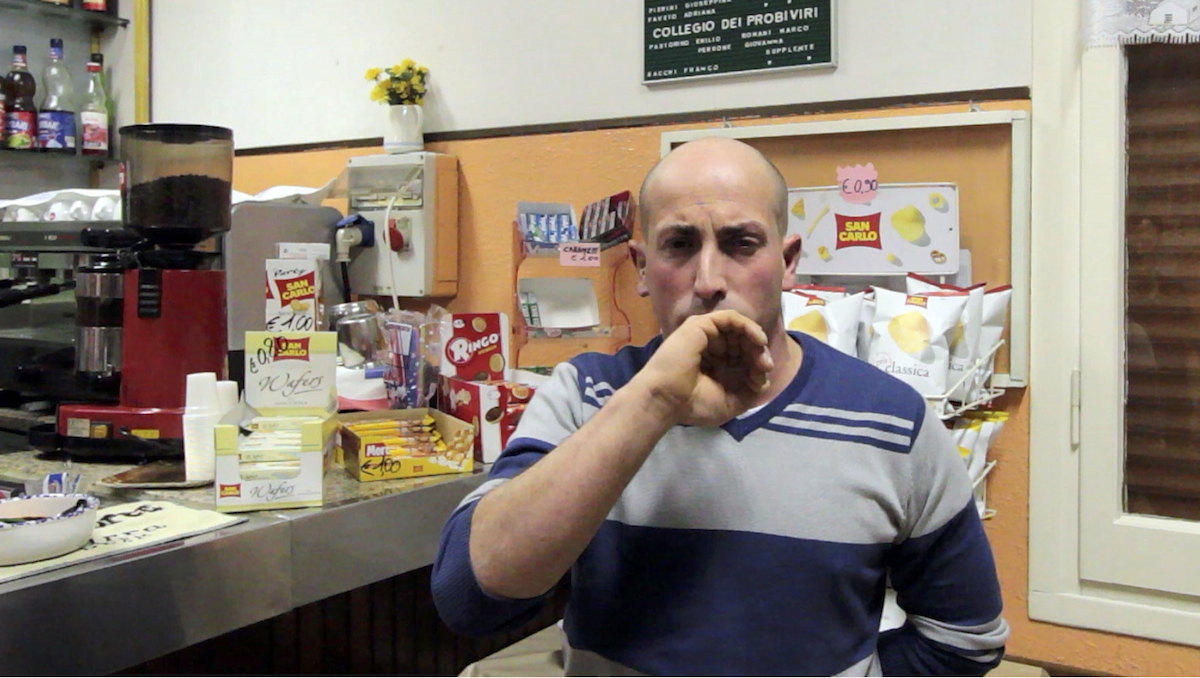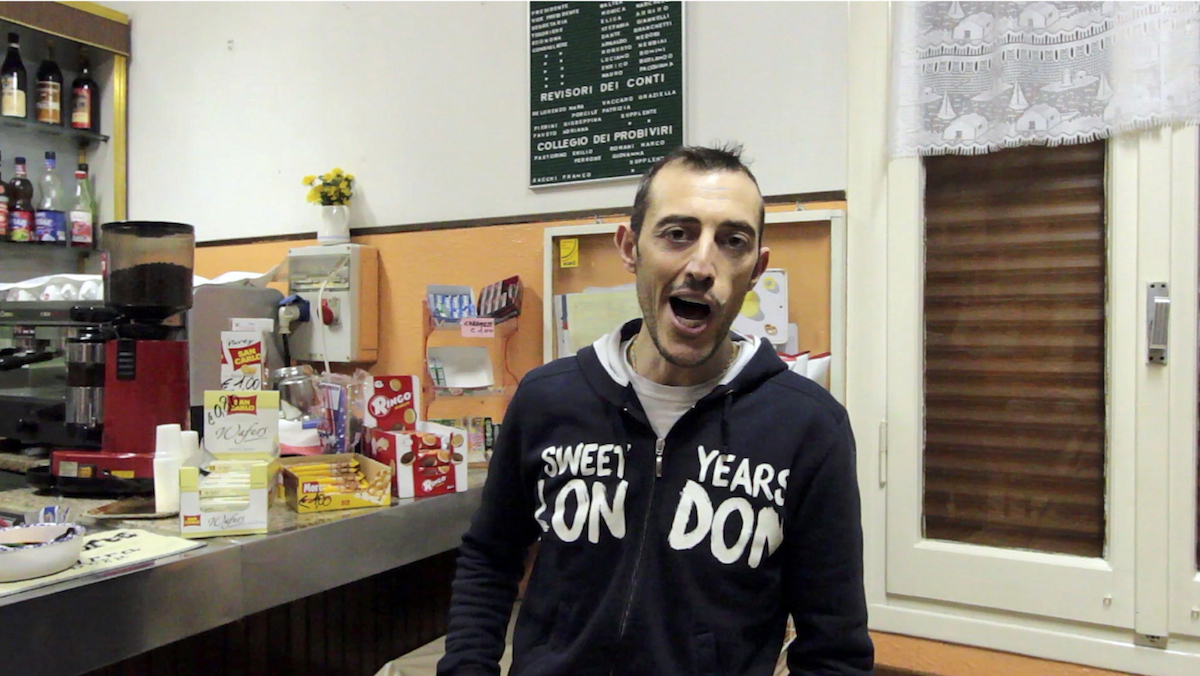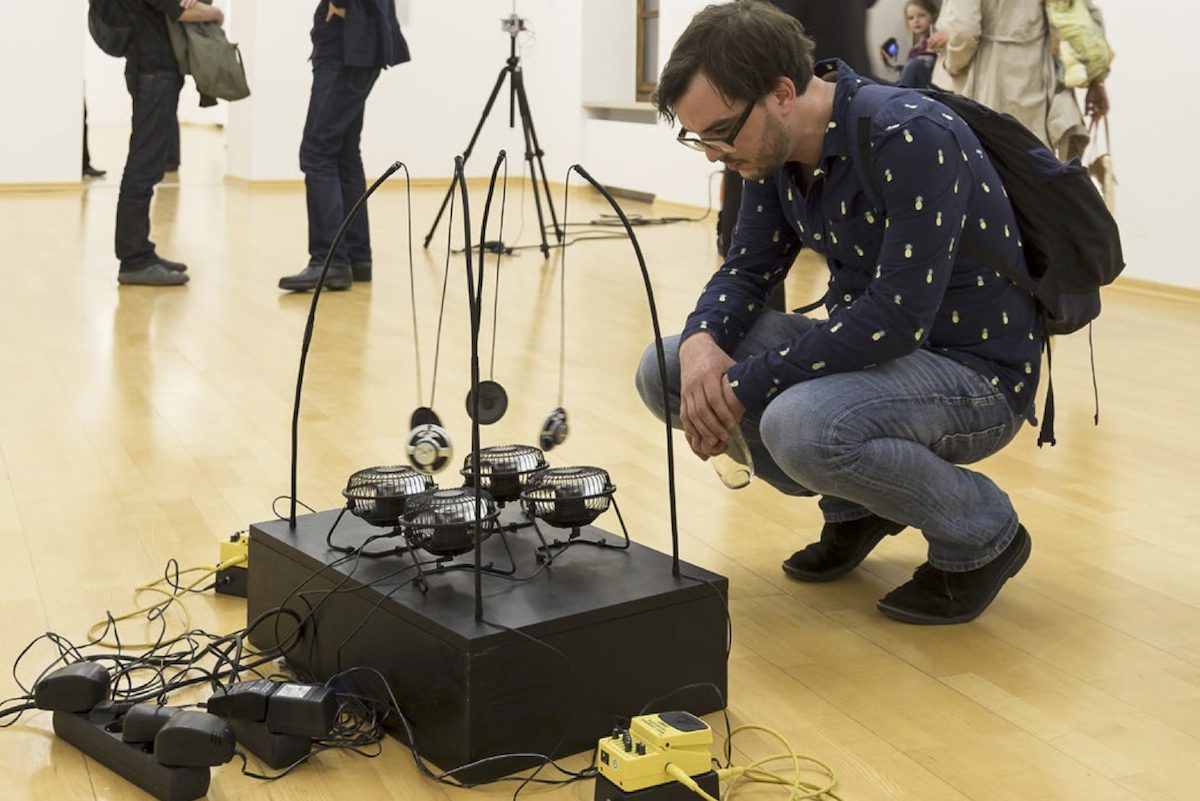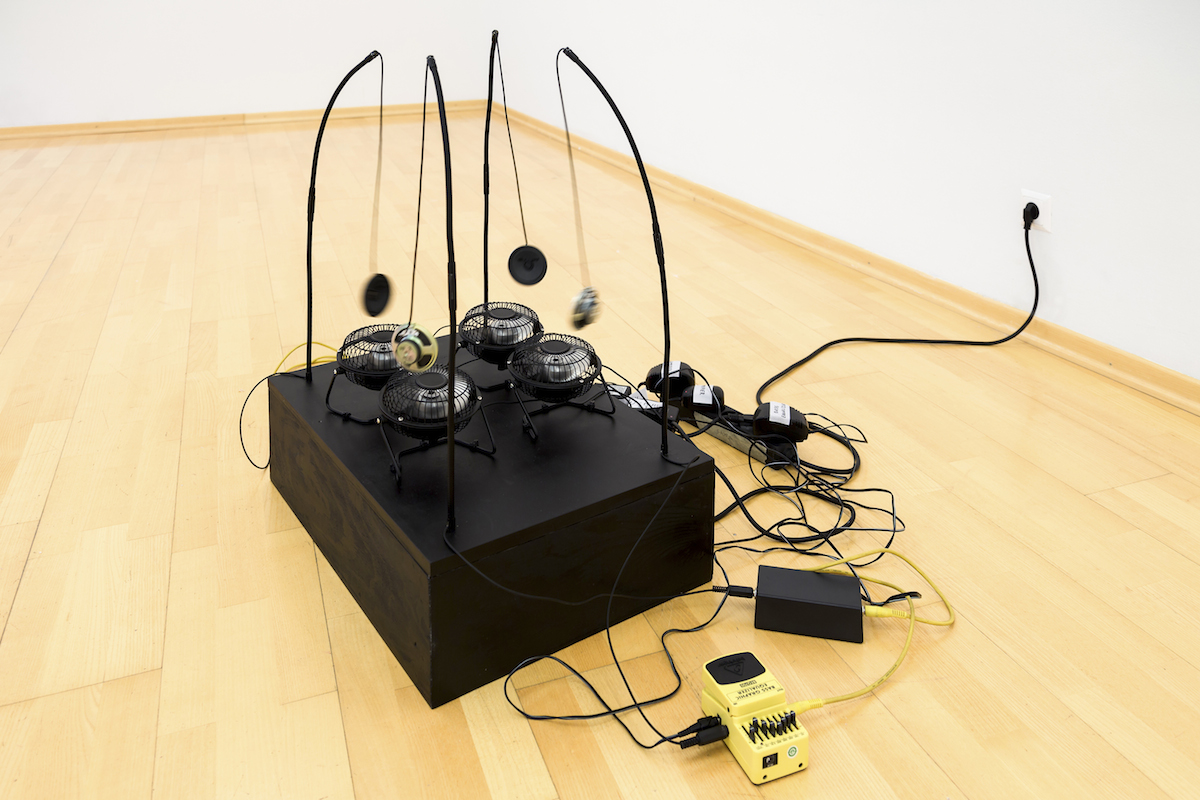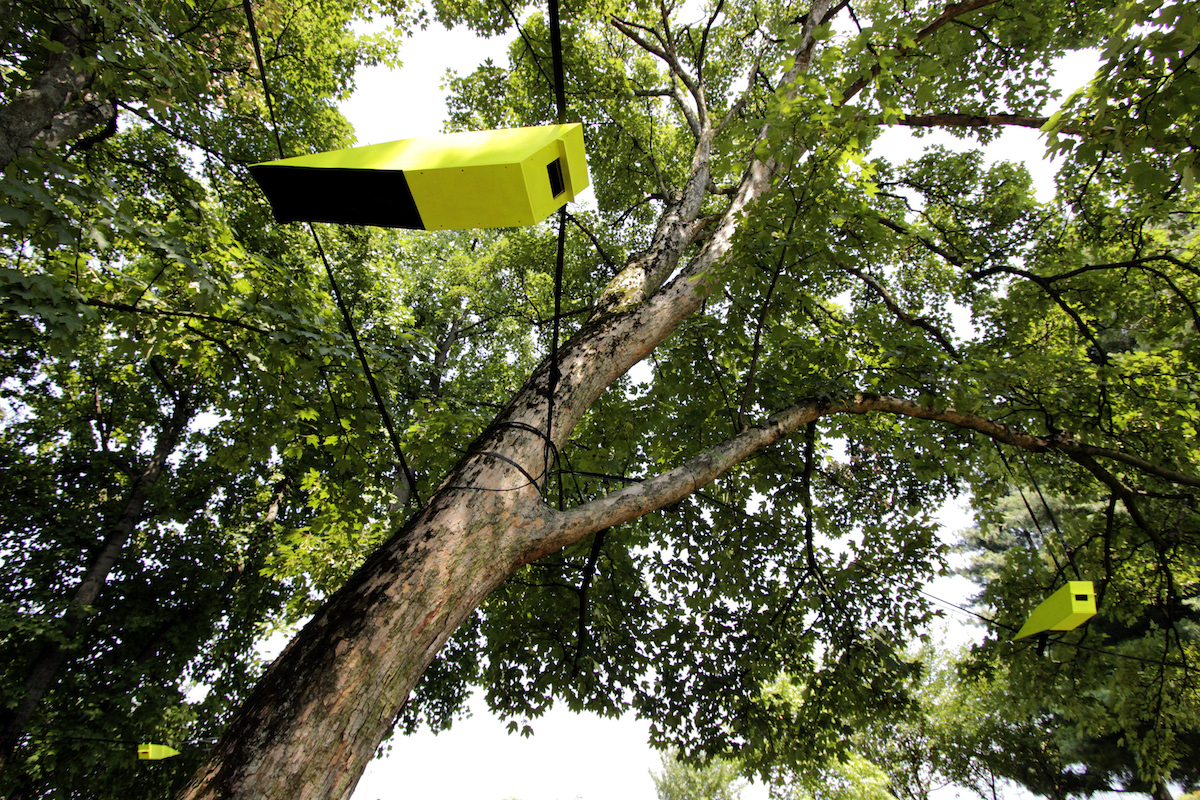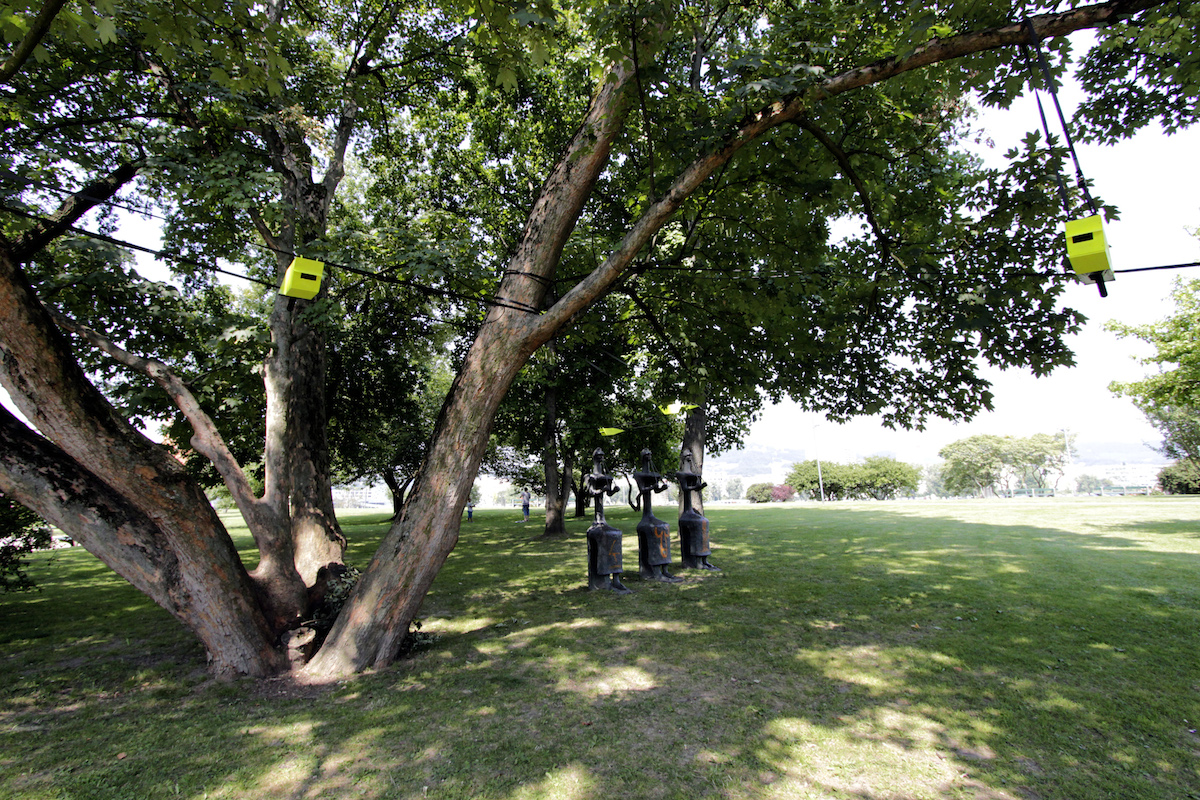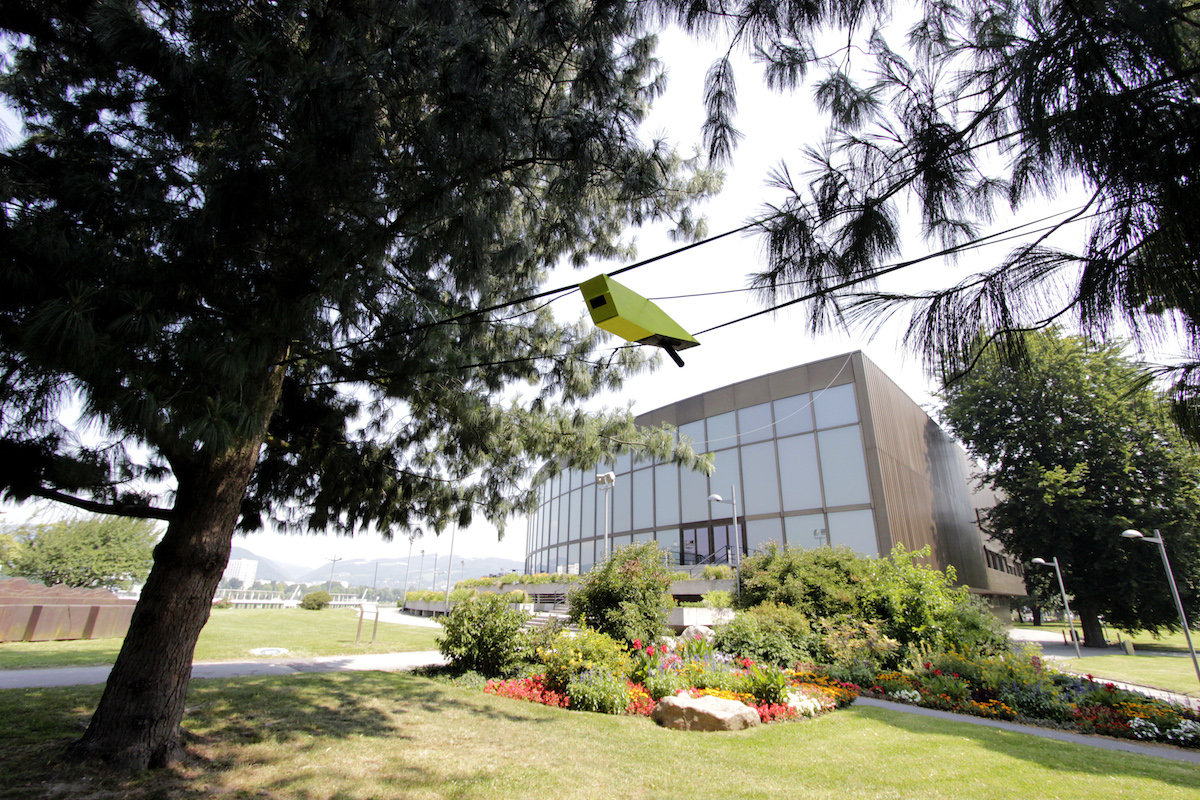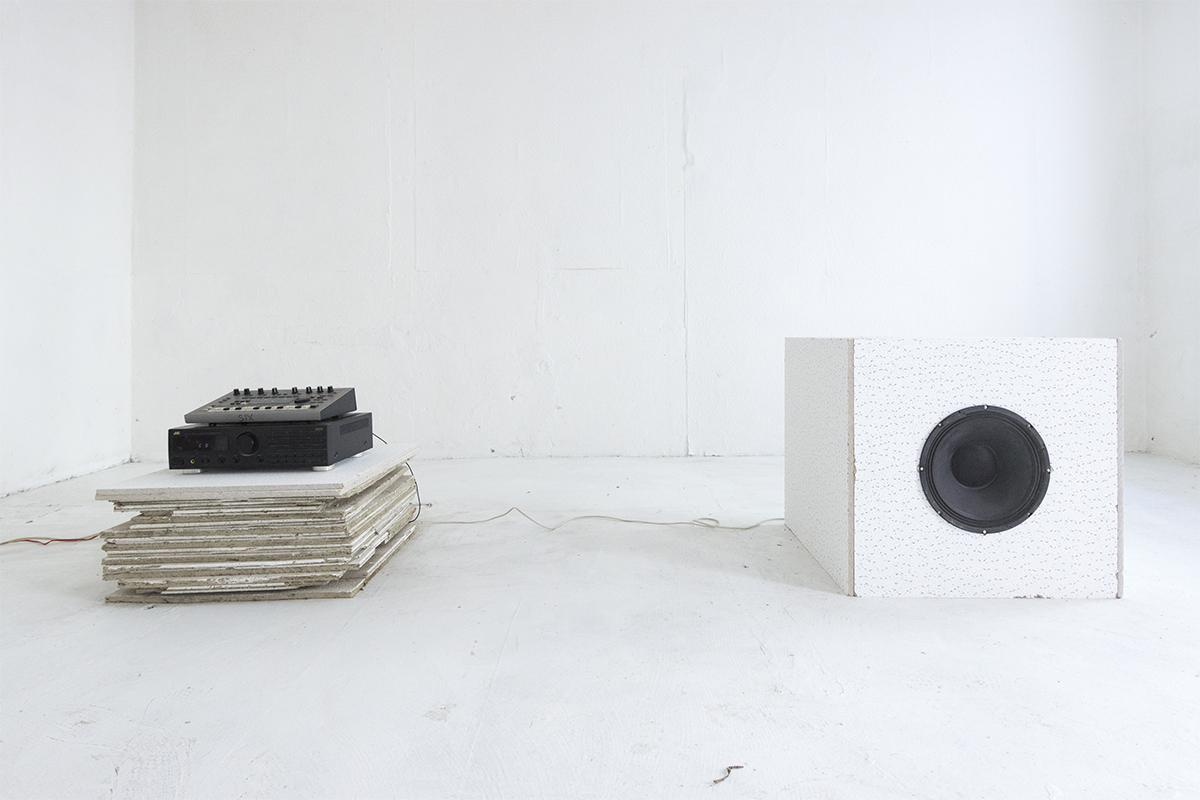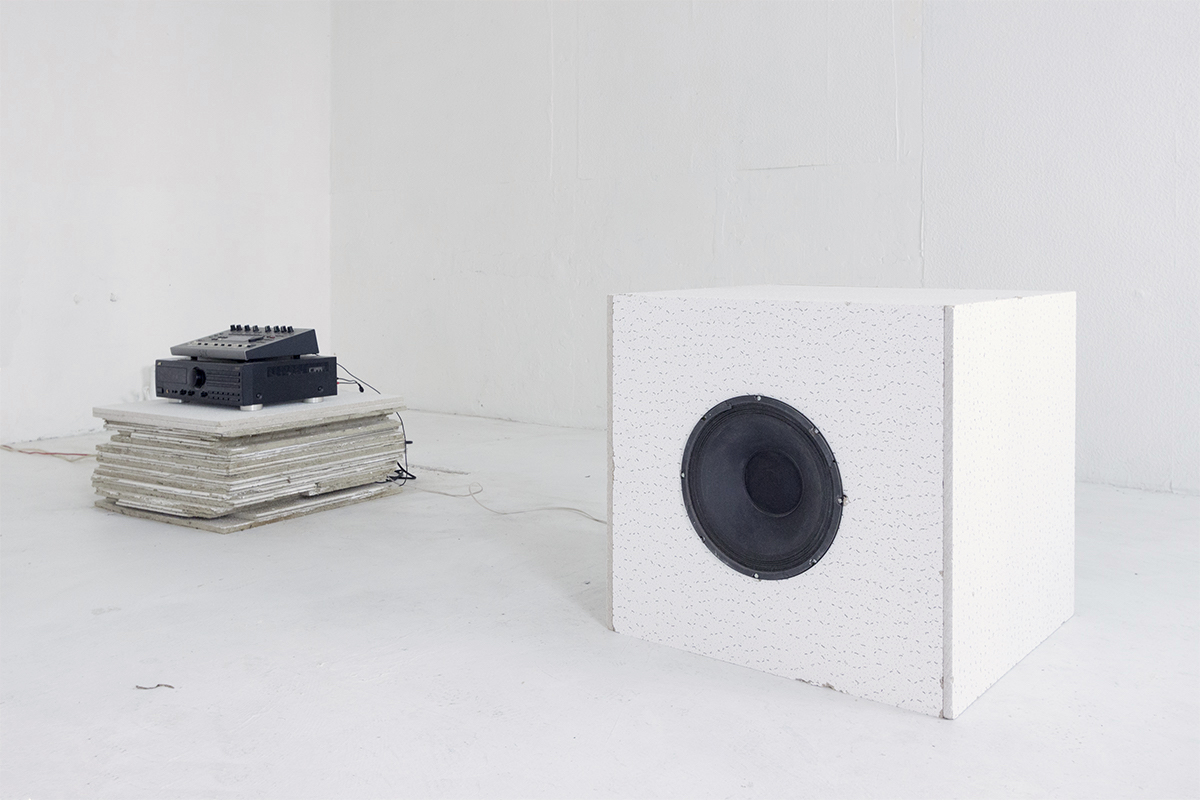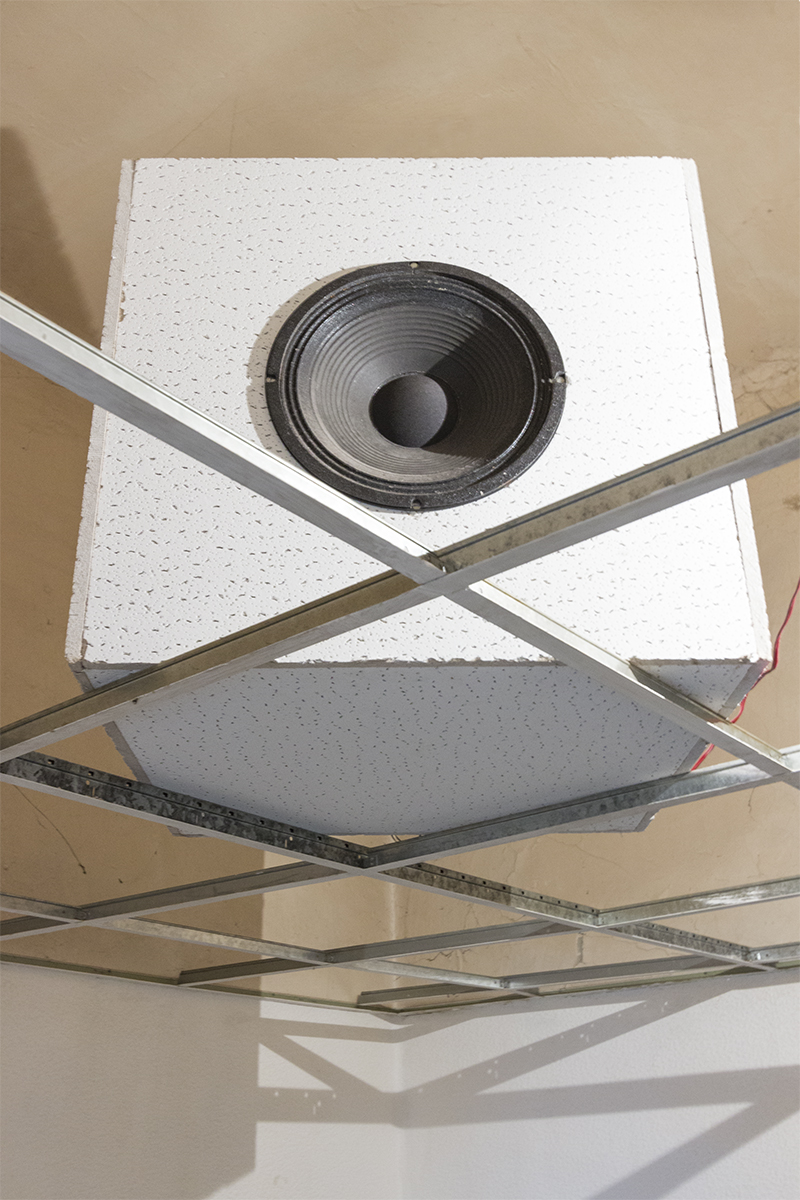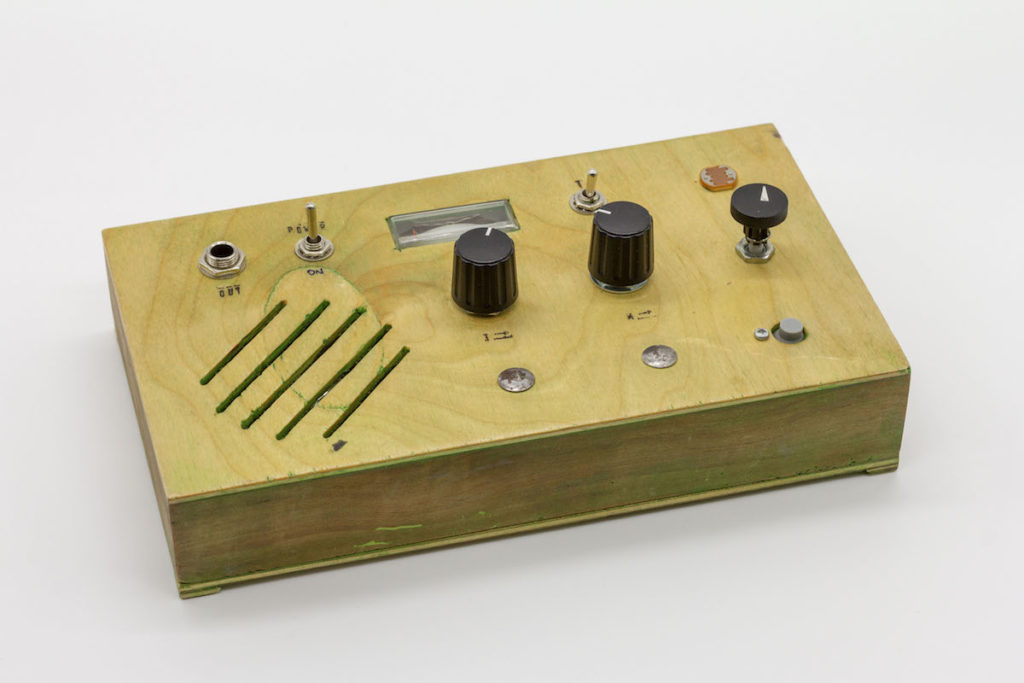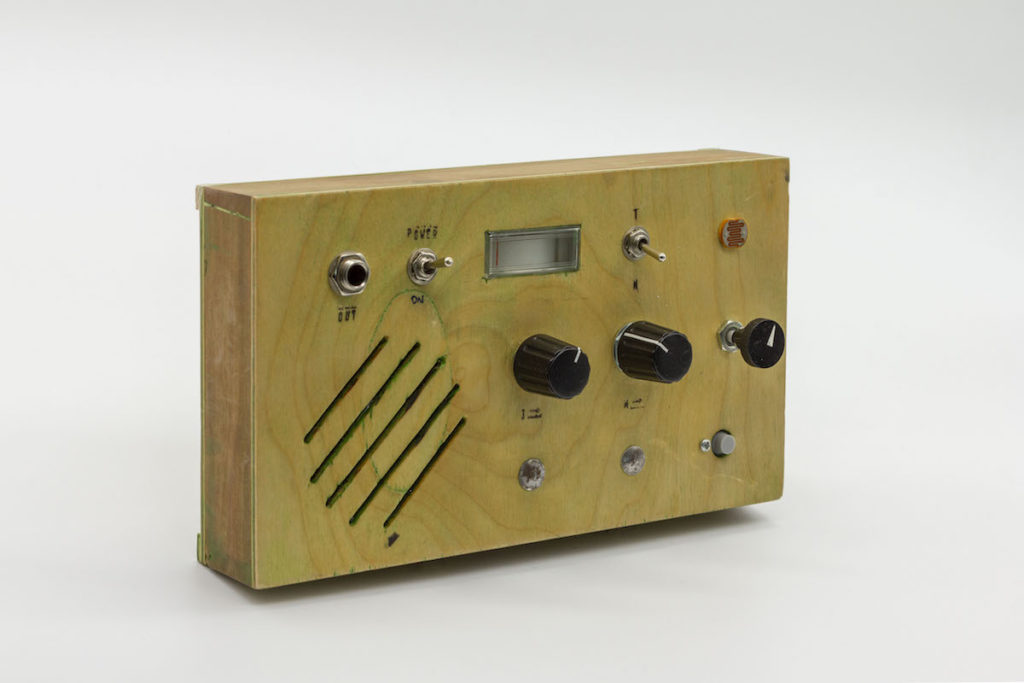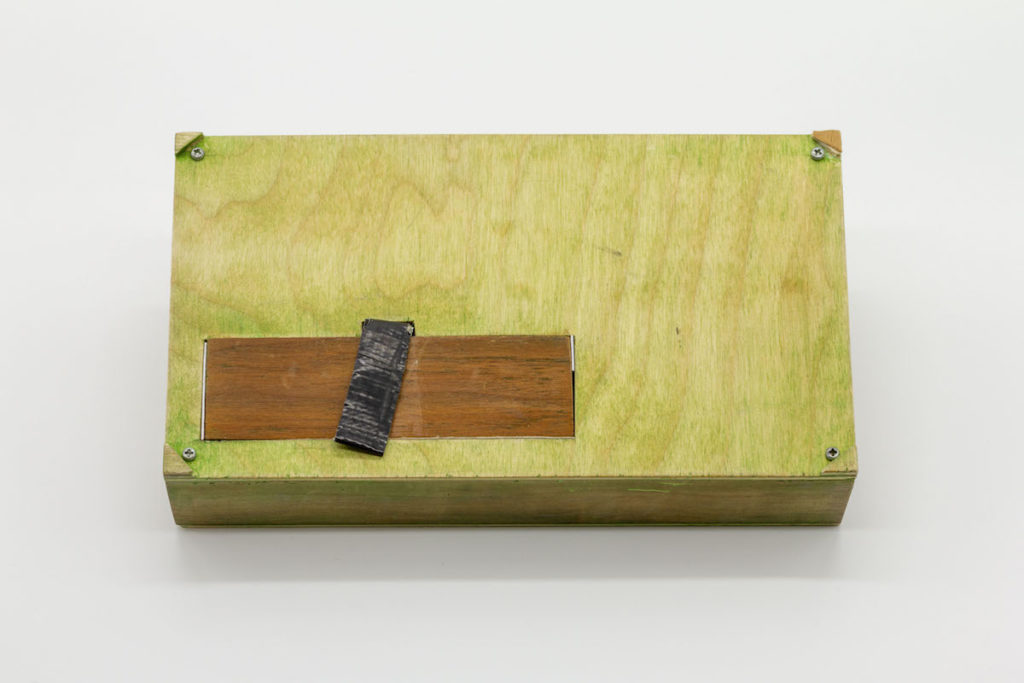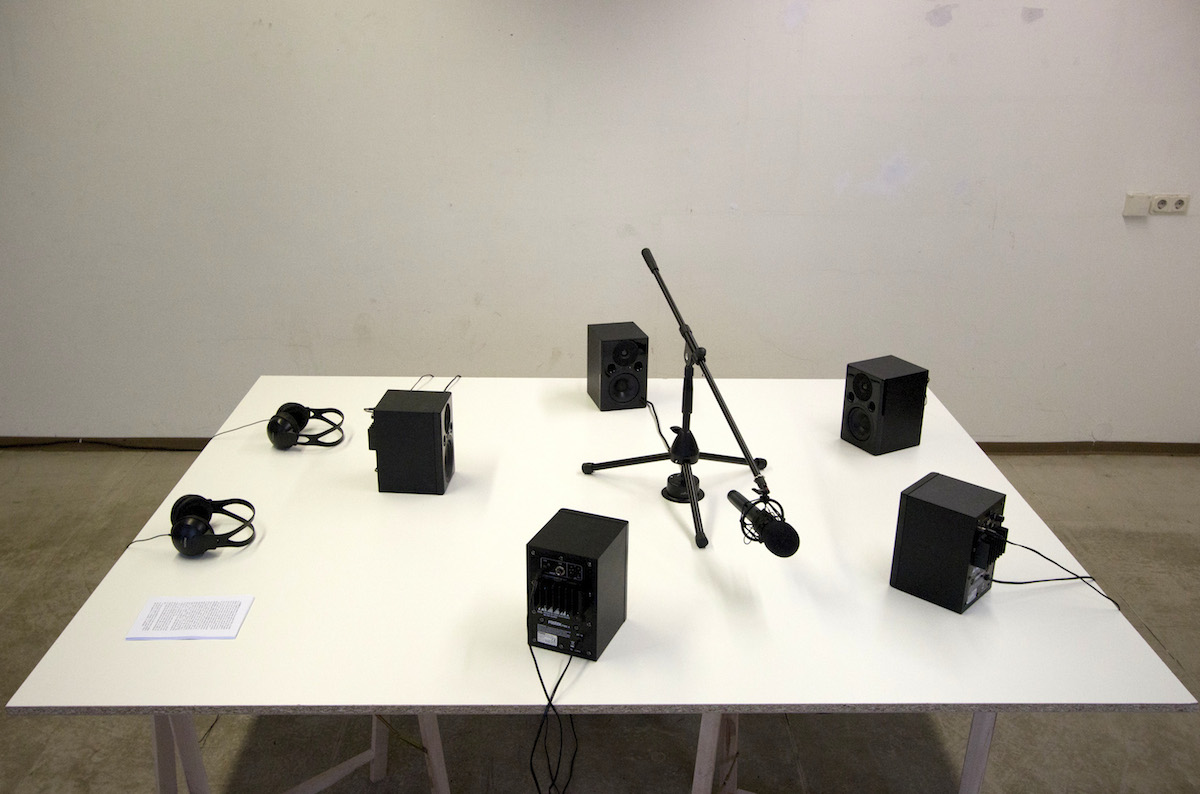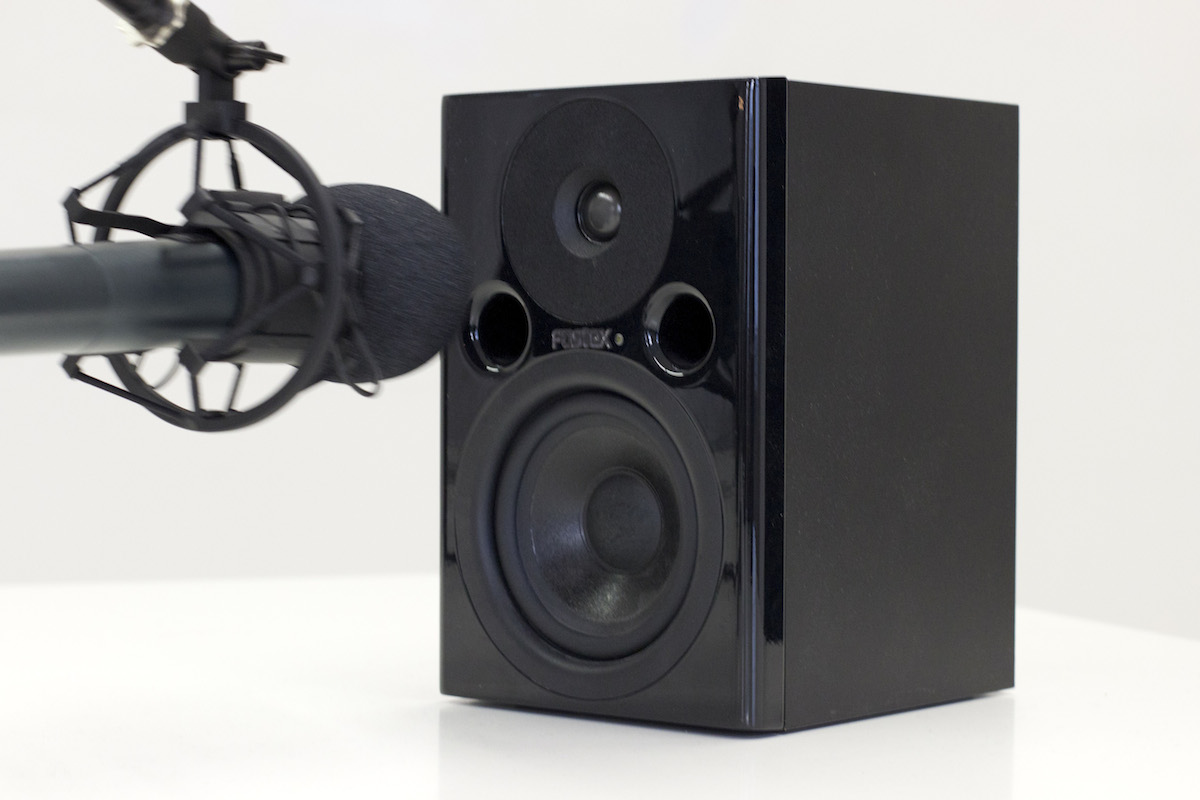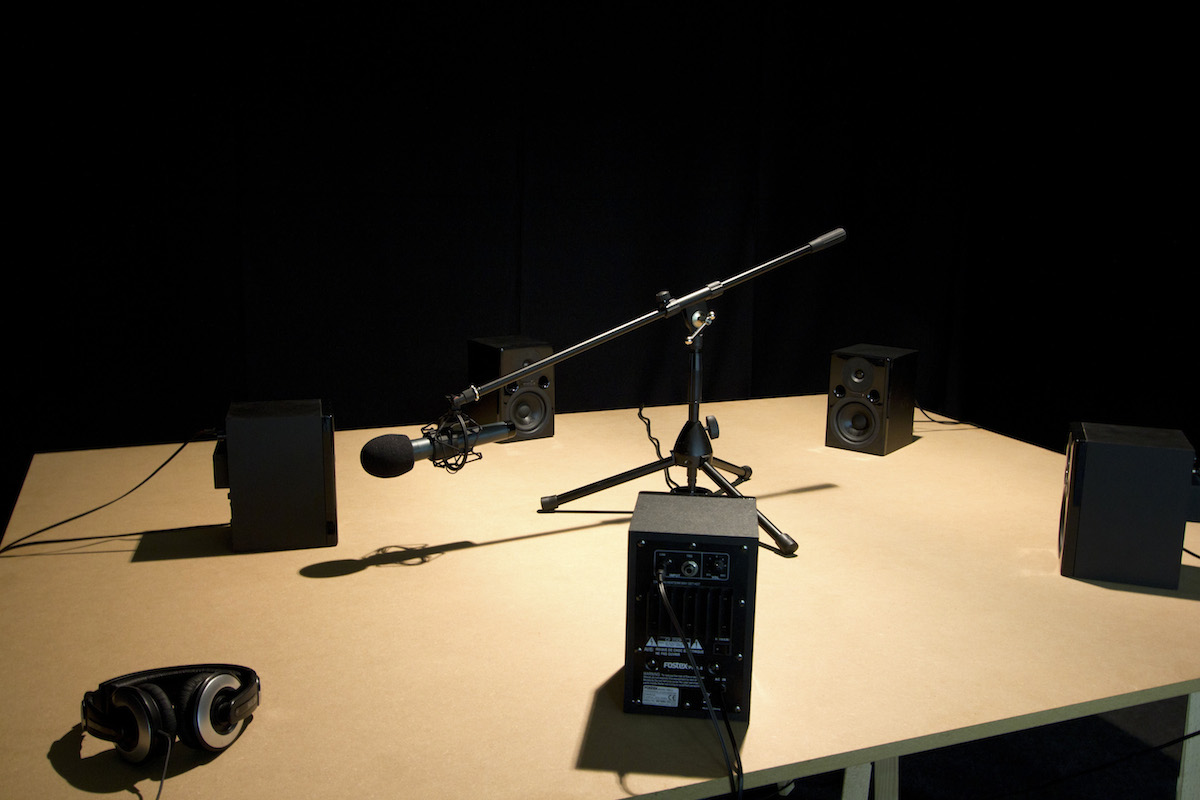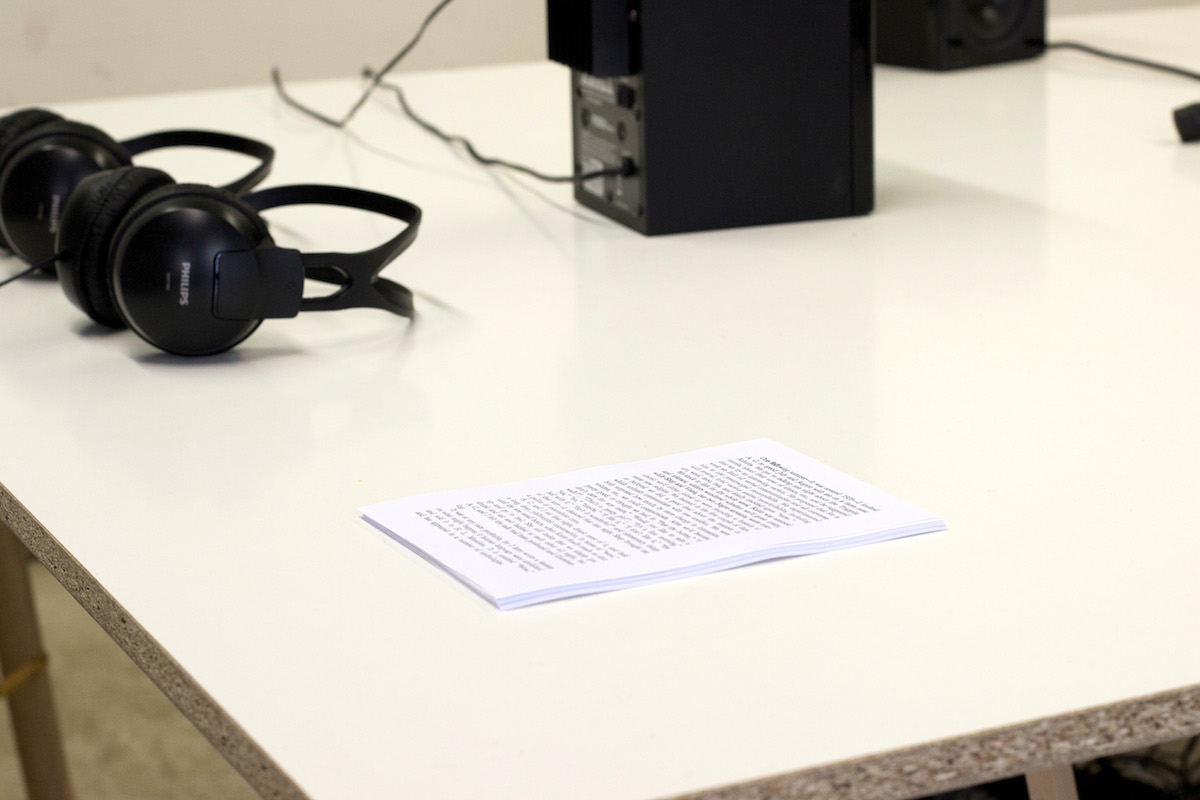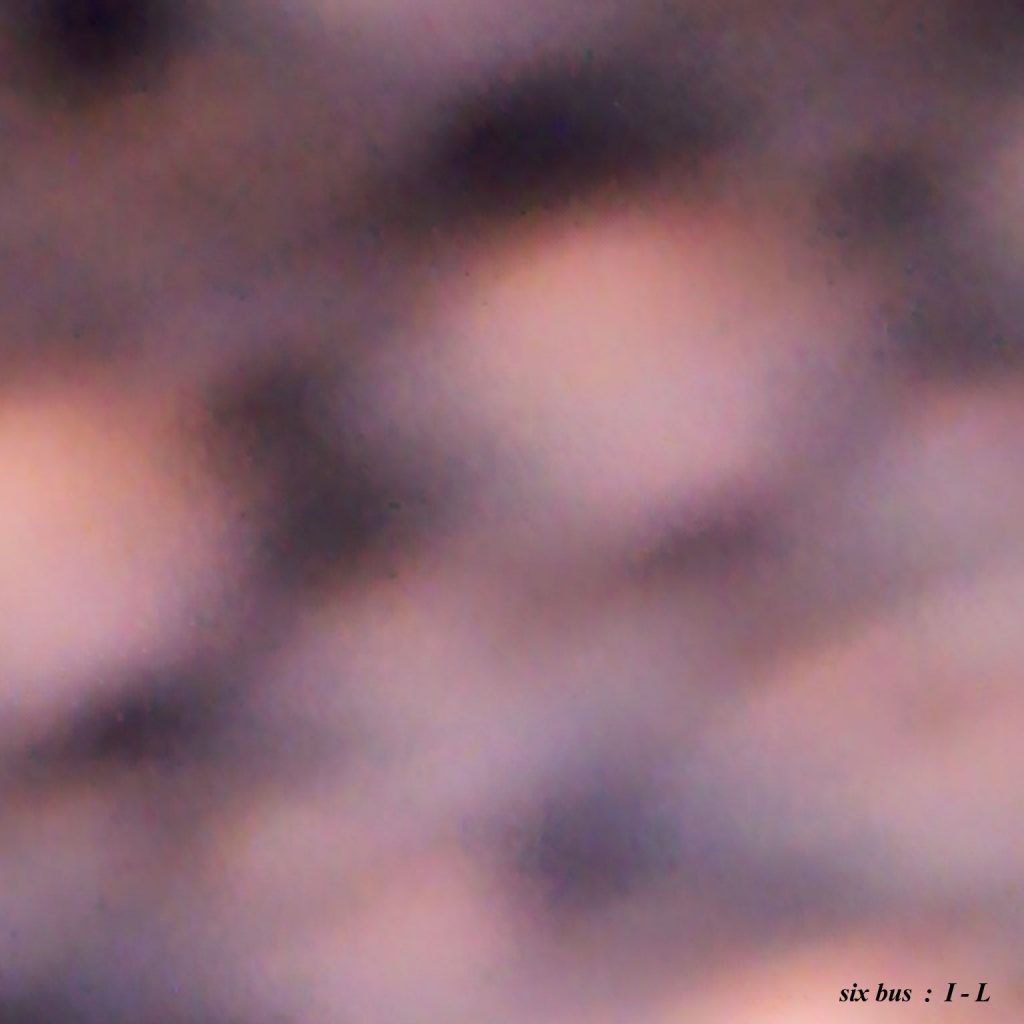REC
as part of FAXEN
Site-specific sound installation, 2014
4-channel audio 2m43s (loop), acoustic absorber panels, speakers, metronomes
Dimensions variable
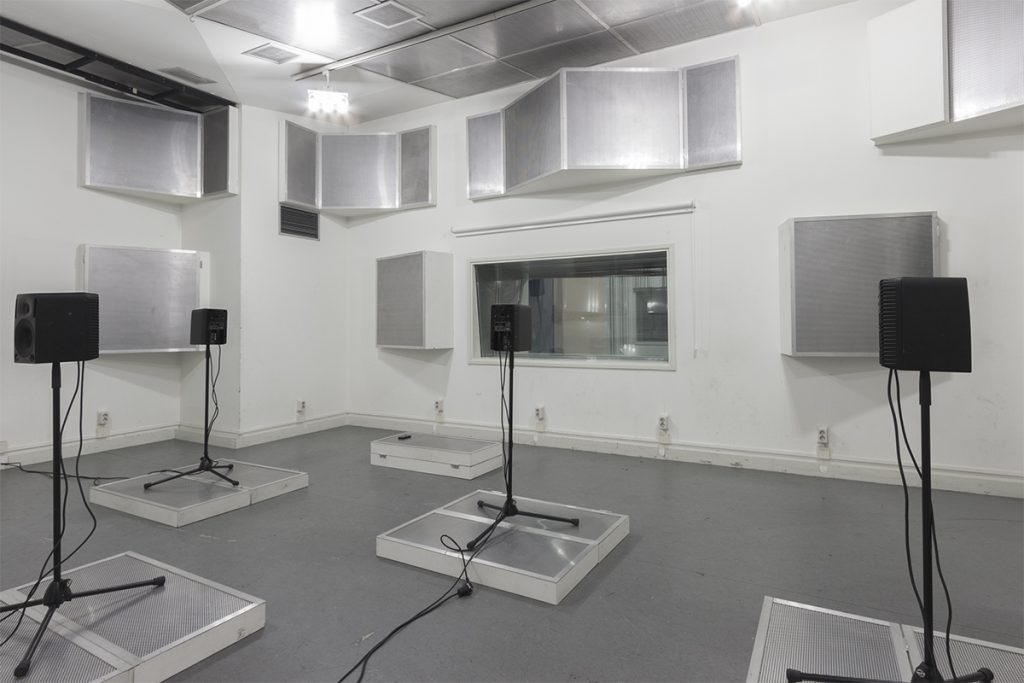
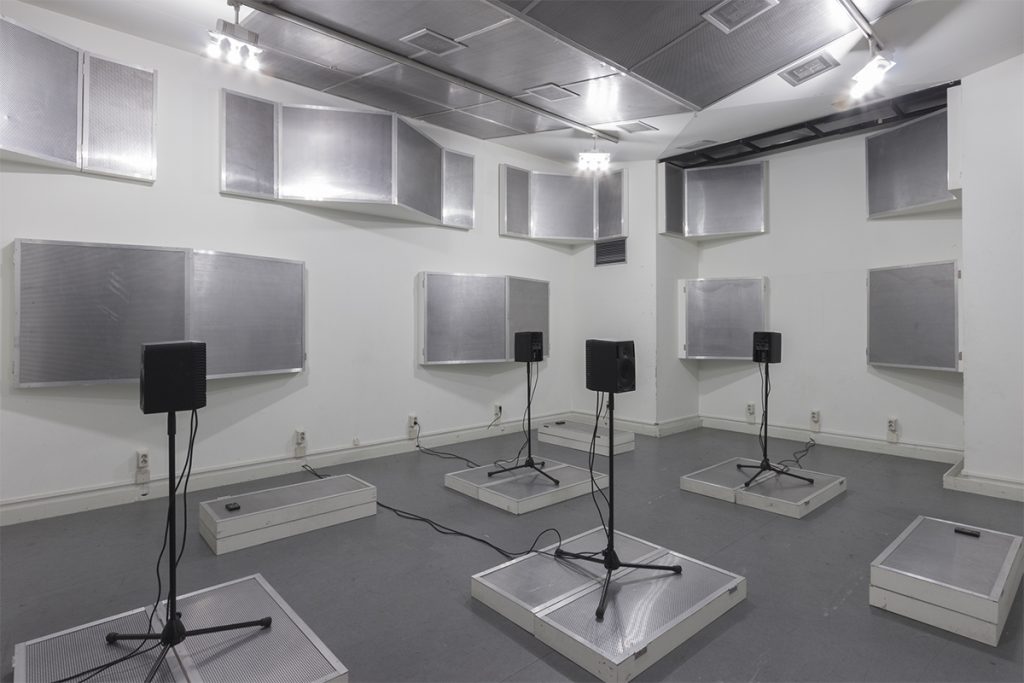
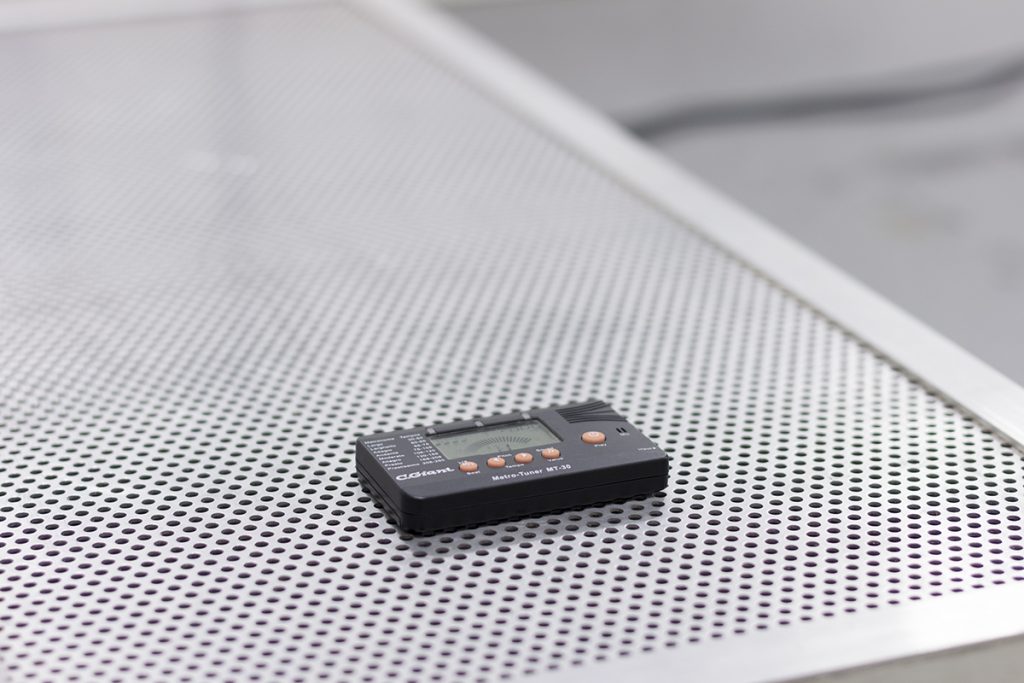
Created for Steim’s Studio #1, REC investigates the architecture, specific acoustics and working conditions in recording studios. This examination shines a light on the unnoticed structures and elements of music production, such as coordination and communication between musicians and the acoustic configuration of the studio.
By demounting and rearranging the acoustic absorber panels from the studio walls, the artist collective Faxen highlights the sculptural qualities of these unique objects. This setting is combined with multiple electronic metronomes and a four-channel sound installation based on various count-ins of historic recording sessions.
Exhibitions
- Studio (take2) | Steim, Amsterdam/NL | 7. – 8.11.2014
Squadra di Canto
as part of FAXEN
HD video 8m30s (loop), 2014
“Squadra di Canto” portrays the vocal group “Canterini Valbisagno” in the outskirts of Genoa. The eight singers perform a typical style of vocal Genovese folk music without the help of instruments, entitled Trallalero. The distinctive feature of this musical genre is the lack of any written scores. Therefore, the singers are required to learn melodies, lyrics, intonation and style through oral repetition only. In this regard, Trallalero can be understood as an embodiment and passing on of distinctive acoustic characteristics of language, class, culture, tradition and musical styles through the voices of the singers. In order to highlight this particular technique of cultural transmission, the video presents each voice separately, giving the viewer the opportunity to witness the process.
Deutsch:
„Squadra di Canto“ porträtiert eine achtköpfige „Trallalero“ Sängergruppe am Rande von Genua. Der Trallalero ist ein Musikstil ohne irgendwelche schriftlichen Partituren, also die Sänger lernen Stil, Intonation, Melodie und Texte durch orale Wiederholung allein. In dieser Hinsicht kann der Trallalero als eine Verkörperung und Weitergabe von charakteristischen akustischen Eigenschaften von Sprache, Klasse, Kultur, Tradition und musikalischen Stilen, durch die Stimme der Sänger verstanden werden. Hervorhebung dieser gewissen Technik des kulturellen Übergangs, präsentiert das Video jede Stimme separat und gibt dem Betrachter die Möglichkeit, den Prozess zu erleben.
Exhibitions
- The Memory in your Pocket, Museo d’Arte Contemporanea Villa Groce, Genoa 21.03 – 01.04.2014
Double Layer (small scale)
as part of FAXEN
Sound installation, 2014
Fans, loudspeakers, wood, Bass Graphic Equalizers
Dimensions: 100x100x80cm
Double Layer (small scale) consists of 4 fans, 4 speakers and a pedestal. The sound installation is the small-scaled version of Double Layer (originally realized in 2011).
Double Layer is a delicately balanced system of feedback sounds, wind and kinetic energy. The airflow from six fans is used to rotate six speakers. Half of the speakers are used as microphones to pick up the fan’s air stream, the remaining speakers to play it back. By and by the sounds evolve through layers of feedback, wind noise and the natural resonance of the space. Double Layer functions as an investigation of cause and effect in a self-contained coupling, where an input produces an output that comes to influence the input once again. What we hear is a fragile structure perpetually on the brink of collapse. This is a special type of network or interaction – an interplay between sound, space and movement.
Deutsch:
Double Layer (Small Scale) besteht aus 4 Lüftern, 4 Lautsprechern und einem Sockel. Die Klanginstallation ist eine Miniatur Version von Double Layer (ursprünglich realisiert im Jahr 2011).In vielerlei Hinsicht fungiert die Klanginstallation als eigenständige Kopplung: Die Transportbox transformiert sich zum Sockel und der Toneingang gibt einen Ausgang, der den Eingang wieder beeinflusst. Der Luftstrom des Ventilators wird verwendet, um die Lautsprecher in Bewegung zu setzen. Zwei der Lautsprecher werden als Mikrofone verwendet, um den Klang der laufenden Fans zu übertragen, die restlichen Lautsprecher, um die Klänge wiederzugeben. Durch und durch, die Töne entwickeln sich durch Schichten von Rückkoppelungen, spielten Geräusche, Ventilator-Sounds und die natürliche Resonanz des Raumes.
Exhibitions
Let’s Overhear
as part of FAXEN
Site-specific sound intervention, 2013
Microphones, parametric speakers, Raspberry Pi computers, wooden boxes
Dimensions variable
Let’s Overhear is an urban intervention which records and analyses the acoustic space while simultaneously playing it back in a modified way. The installation focuses on the specific sonic characteristics and qualities on site, which influence the musical interpretation of the existing soundscape. The setting allows listeners to expand their acoustic horizons and examine their perception in interaction with the composition. Let’s Overhear transforms the environment into a composed soundscape – an urban setting full of sounds.
Deutsch:
Let’s Overhear war eine urbane Intervention, welche den akustischen Raum der Stadt aufzeichnete, analysierte und modifiziert wiedergab. Im Mittelpunkt der künstlerischen Auseinandersetzung standen die akustischen Eigenschaften und Qualitäten vor Ort, welche den Ausgangspunkt für die klangliche Umsetzung der Installation bildeten: Eine musikalische Interpretation der vorhandenen Geräuschkulisse die es den BesucherInnen/ ZuhörerInnen ermöglichte ihren akustischen Horizont zu erweitern und das täglich Gehörte im Wechselspiel mit der Komposition zu überprüfen. Ziel, war das akustische erlebbar machen eines urbanen Ortes sowie eine gesteigerte Wahrnehmung für einen urbanen Klangraum als durch-komponiertes Soundscape. Denn das Städtische, wie Walter Benjamin es skizziert: „Bauten und urbane Umgebung werden auf doppelte Art rezipiert: durch Gebrauch und durch Wahrnehmung“. 2 Eben diesen Gebrauch und diese Wahrnehmung machte Let’s Overhear hör- und erfahrbar.
Exhibitions
- Let’s Overhear, Donaupark Linz, 22.07. – 04.08. 2013

Testing the Equipment
as part of FAXEN
Site-specific intervention, 2013
Sound-absorbing tiles, loudspeakers, Roland MC303 synthesizer
Dimensions variable
The sound installation “Testing the Equipment” is dedicated to the overlooked significance and qualities of acoustic ceiling panels. These universally used components are typical of modern architecture and define the acoustic characteristics of indoor spaces, such as offices, schools, shops, etc. As a first step, the artist group FAXEN removed all ceiling panels from the exhibition venue in order to manipulate the acoustics of the space. The collected panels then served as construction material for two custom-built speakers, each of which plays a bass drum sound that explores the room’s resonance.
Exhibitions
- Testing the Equipment (solo show), AfG, Vienna/Austria, 2013
Triade
sound object, diy instrument, 2013
mixed media, tape heads, motors
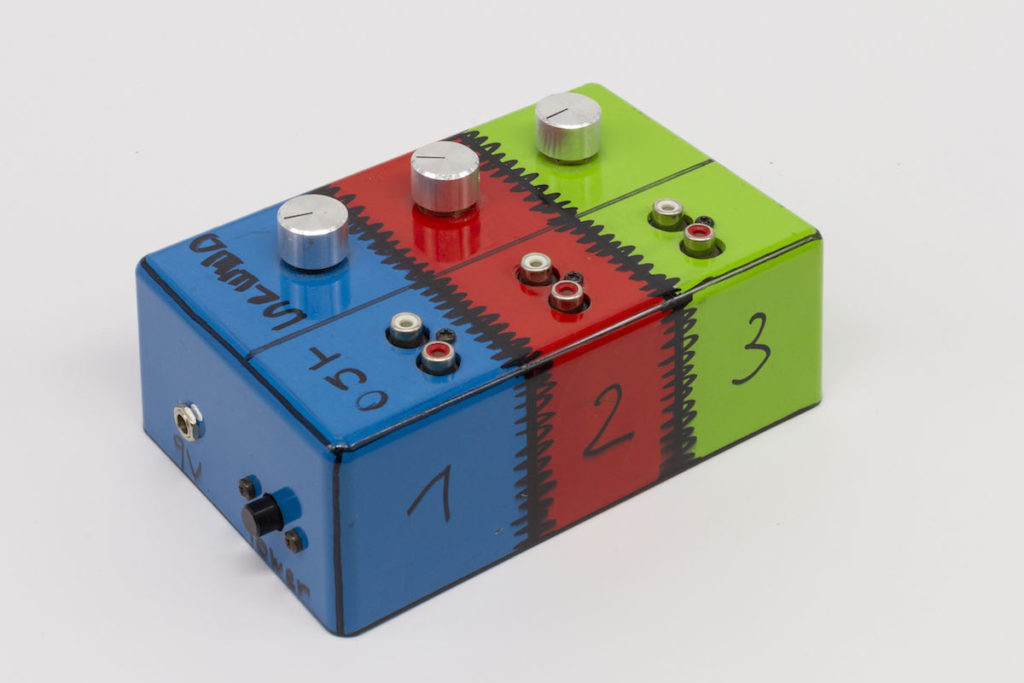
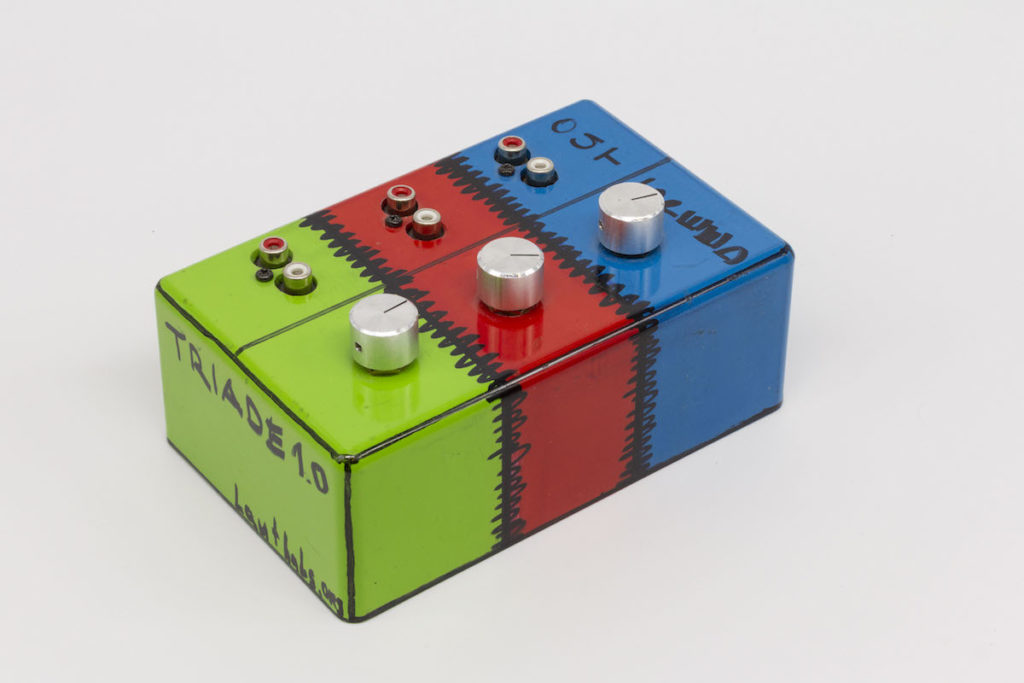
Triade nennt sich mein erstes ‚Magnetton‘-Instrument. Es besteht aus drei Motoren, die mit drei MC-Tonabnehmern abgenommen werden und so einen maschinellen Dreiklang erzeugen.
Tischhupe
sound object, diy instrument, 2012
mixed media, sound chips
A shitty little toy keyboard hacked an putted into a nice handmade wooden box. Voilà: The Tischhupe.
Features:
Build in Speaker
Output Jack
No Volume knob!!
Main Pitch/WTF
Tone/Melody Switch
Melody Pitch
Tone Pitch
Light Sensor
Body Contacts
Button
Used as instrument in performances and releases:
Wow
as part of FAXEN
Multimedia installation, 2012
5-channel audio, microphone, mirror ball motor, speakers, table, text excerpt of William B. Seabrook’s book Witchcraft, Voice: Sam Bunn
Dimensions: 200x200x150cm
The sound installation “Wow” explores a text by American author William B. Seabrook entitled “Wow!”, a reflection on what might happen if human language were abolished. Seabrook’s short story is based on an experiment with Aleister Crowley. In 1920, after a conversation about Trappist monks and their vows of silence, they both agreed to suspend normal verbal communication and limit themselves to the predetermined monosyllable “wow” for a week. Based on this experience, Seabrook wrote the short story “Wow!”, set in ancient China, in which people discover peace and contentment through replacing human language with the word “wow”; eventually, a second fraction emerges, those who spread dissent by using “wo”. In consequence, two great armies fight to the death over “wow” and “wo”, leaving nothing but “a few empty bubbles floating on a river of blood.”
Upon approaching the sound installation, visitors experience a blended soundscape of multiple voices. A slowly rotating microphone passes by a circular array of speakers playing back fragments of Seabrook’s short story. By putting on headphones, the listener can hear a steady fading in and out and experience a mechanical remix of Seabrooks’s text that is constantly generating new and unexpected combinations.
Exhibitions
- FINE SOUND – keine medienkunst | Das Weisse Haus, Vienna/AT | 20.2. – 30.3.2013
- Alle Worte sind aus! / All words have run out! | Kunstraum Goethestrasse xtd, Linz AT | 17.10. – 14.12.2012
I-L
as sixbus
Album Release, 2012
digital file
The new field recording single of sixbus is here to listen and download. The two pieces were produced on specific occasions in 2009. The first track originated during rehearsals for a concert at the Playground Festival in Innsbruck. The second was part of the project Radiospotting which took place in Linz.
Nebenstelle
sound object, diy instrument, 2012
mixed media, vocoder, telephone
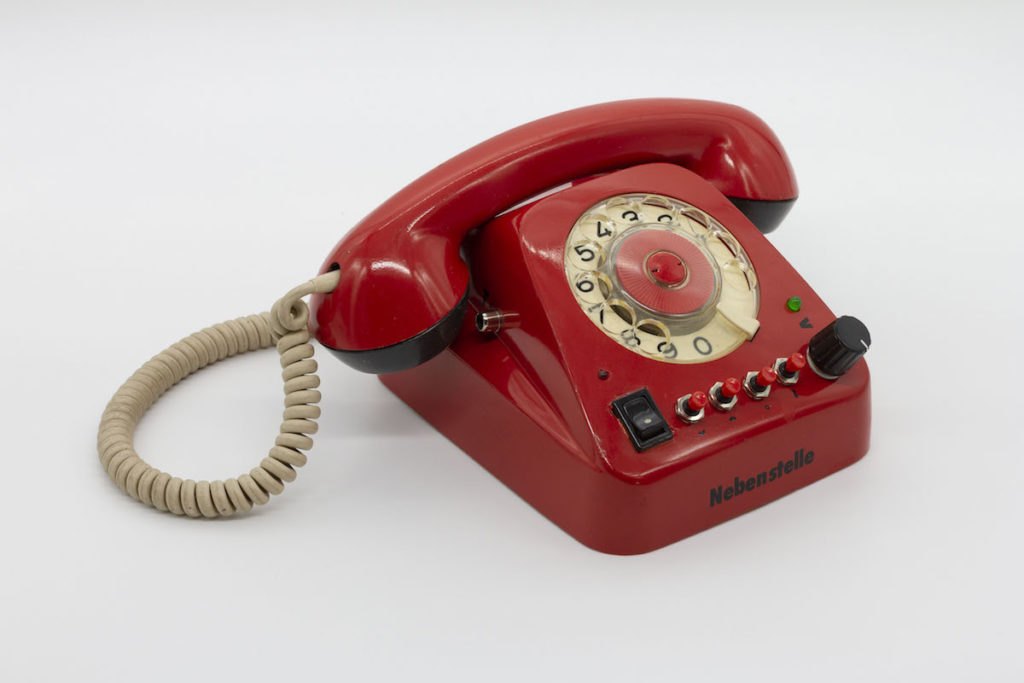
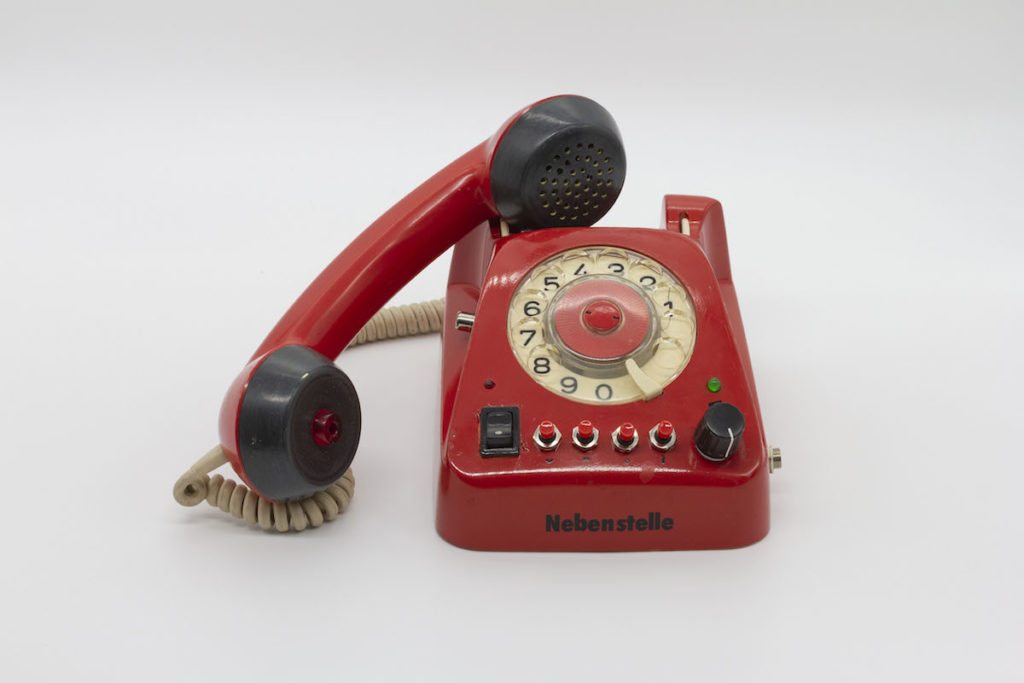
Ein altes Telefon mit eingebautem Vocoder und rot lackiert wird zur Effektschleuder.
Used as instrument in performances and releases:
- MENU Festival, Hradec Králové/CZ, 2016
- sixbus – Feldsaiten, 2014, Album, Lauthals
- Realoase, Autark, file, 2008
- The Hitman Demo, Lauthals, 2007
- may he hetal?
